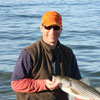Several Practical Ways Eel Bait is Used by Savvy Anglers
By Tom Keer
Nov 22, 2017
There is a reason that savvy anglers fish with eels. They're simple to rig, easy to use, and can be bought at a bait shop or caught on your own. The biggest reason to fish with eels is that they catch big fish.
Long before there was 'click bait' there was 'eel bait.' They're deadly, and many eel fishing rigs are commonly used by night fishermen targeting striped bass. In my Cape Cod homewaters a freshwater eel fished at the right depth accounts for some of the largest stripers of the season. Bob Rocchetta made history when he caught a 76-pound striper at night while using eel bait.
As a fish species, eels live in freshwater and move to the saltwater to spawn which is opposite of anadromous fish. The black snakes vary a little bit in size with popular eel fishing bait lengths ranging between 2-3 feet long. Older eels can grow up to five feet in length.
1. Eel fishing bait rigs
There are a few different methods for rigging eels and they're based on the current speed. In slow current, tie the tag end of your fishing line to a barrel swivel (a Uni Knot works great). Then, tie a two-foot leader of between 40 and 50 pound test flurocarbon to the opposite side of the swivel (think Uni Knot again). Tie the tag end of the leader to a 5/0-7/0 circle hook and you're done. In fast current, tie your fishing line to one eye of a three-way swivel. On the rear swivel eye you'll then tie a three-foot leader of between 40 and 60 pound test flurocarbon. Complete the rig by tying a hook (5/0-7/0 circle hook) to the leader. Add weight to the bottom eye. A bank sinker tied on 20-pound test at a distance between one and two feet from the swivel works best. Go as light as you can for if the sinker hangs in the rocks it's easy to break it off. Match the sinker's weight to your current speed, with heavier weights working the best in stronger currents.
2. Eel fishing methods
Fishing live eels is simple. The hardest part is containing these slippery beasts, so cool 'em down by putting 'em on ice (eels move slower when they're cold). Then, grab 'em with a rag and thread the hook's point up through the lower jaw and out through one eye socket.
3. American eel fishing techniques
Gently cast the eel towards the target spot, open your drag and let the eel swim into holes, along side a rip, or in and around rock gardens. When you feel a bump point your rod tip towards the spot where you felt the hit, put your reel in gear, and reel in the slack line. The fish will turn to run and when you add pressure they'll hook themselves.
If you're looking for big striped bass give 'eel bait' a try. They're better than click bait anyway...









